- | 9:00 am
Dubai Design Week spurs a new era of art and design centered on sustainability
The installations and exhibitions unfold at the intersection of progress and preservation.
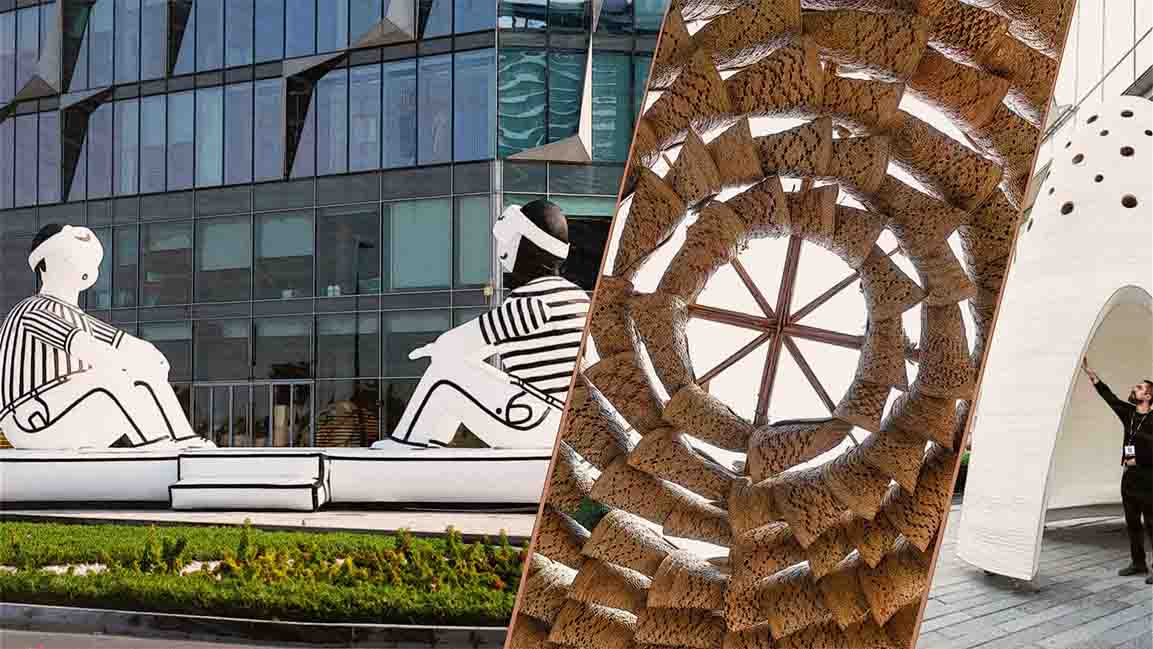
There’s a dichotomy between technological prowess and environmental preservation that emerges in the relentless pursuit of innovation and creativity. It is within this intersection Dubai Design Week unfolds.
At the annual event, artists are wielding their creativity to shed light on the discord between progress and responsibility.
As mediators between business, technology, and people, artists bring meaning, creativity, and innovation to complex or often worthy causes, building artworks that capture hearts and minds and change people’s actions and behavior.
And getting this right could herald a new era of creative sustainability: better for the industry and the world.
This year’s theme builds on the UAE’s Year of Sustainability, with architects and designers exploring related themes. From traditional design practices, emerging technologies to environmental sustainability, innovative materials, and design-led solutions for vulnerable communities,” said Mette Degn-Christensen, Fair Director of Downtown Design.
Khadija Bastaki, Senior Vice President of Dubai Design District (d3), emphasizes the urgent need for future-proof and environment-continuous design thinking. “The design community is integral to achieving the global sustainability agenda. The design sector covers architecture, interiors, art, fashion, and product development, each with multiple touchpoints in our daily, professional, and commercial lives. Creatives determine the buildings we live in, how we navigate our cities, how our world is landscaped, the interiors and furniture we live with, the clothes we wear, and how we innovate for the future.”
Design is a powerful tool shaping our world. Interestingly, design contributes to more than half of the creative economy’s GDP, which is 4% of the economy. Dr Saeed Mubarak bin Kharbash, CEO of the Arts and Literature Sector at Dubai Culture, says Dubai Design Week is a fundamental pillar of the creative economy. “We are working with stakeholders in the design sector to implement a full design strategy that will be unveiled in the next few months.”
GLIMPSES OF A GREENER CITY
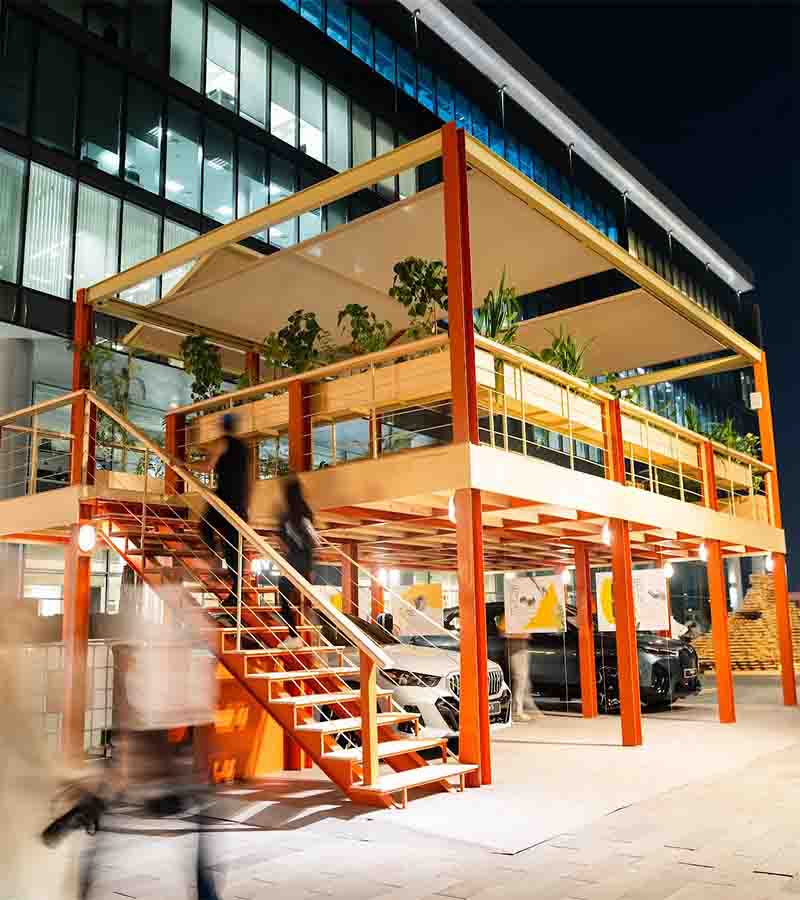
Urban Hives by Nathalie Harb x BMW. Courtesy: Dubai Design Week
Looking ahead to the future of urban landscapes, Beirut-based designer Nathalie Harb’s innovative Urban Hives concept involves the creation of a lateral car park area with a garden situated above, serving as a protective shield against the sun’s impact on vehicles. Harb says, “If the sun hits a garden instead of the road, the heat island effect will be much less. While data is limited, the concept of the garden rooftop acts as a guard of the car.”
The garden operates on a self-sufficient model, featuring a solar panel and a rainwater collection system to sustain its greenery. Beneath the surface lies a concealed irrigation system, showcasing the thoughtful integration of technology and nature in this prototype.
Harb proposes the implementation of such gardens atop parking spaces as accessible public areas, emphasizing the potential for widespread adoption of this eco-friendly concept.
She highlights the collaboration with BMW and the shared commitment to sustainability: “The idea is to use a private space like a parking area and turn it into a public space, creating a conversation between the designer, industry, and municipality.”
This collaborative effort extends beyond conceptualization, actively engaging various stakeholders in realizing a greener and more sustainable urban environment.
Maziar Nazari, Experiential Marketing Manager at BMW Group Middle East, emphasizes that sustainability goes beyond electrification, encompassing using sustainable car materials. “Every element used in our cars is made from sustainable materials. The aluminum used is from Emirates Global Aluminum, sourced from solar. We recycle PETs and fishnets to create our cars.”
He underscores the notion that luxury and sustainability need not be mutually exclusive, emphasizing the tangible manifestation of this ethos in the collaborative project with Harb.
OF PALM

Of Palm by Abdalla Almulla. Courtesy: Dubai Design Week
Emirati designer Abdalla Almulla’s creation, Of Palm, takes center stage in the Abwab pavilion in the array of large-scale installations.
Almulla draws inspiration from the indigenous palm tree, transforming its various components into a multifaceted architectural masterpiece, a concept deeply rooted in the ethos of scarcity, urging a reconsideration of how natural resources can be repurposed for functions beyond their original scope.
Every pavilion element, from the flooring to the furniture, columns, ceiling, and food, is crafted from the palm tree.
The pavilion’s roof comprises approximately 700 mats intricately woven from palm leaves, showcasing the versatility of this traditional material. Almulla’s vision is deeply rooted in the historical use of the palm tree for shelter, heat, fuel, and sustenance, providing a harmonious blend of heritage and contemporary design.
Almulla sees Of Palm as an extension of an experiment initiated at Hermes’ Dubai mall store, where palm woodwork on the ceiling fused French culture with local aesthetics. The pavilion, therefore, becomes a testament to the seamless integration of cultural influences and a celebration of sustainable design practices.
Reflecting on the construction process, Almulla highlights the paramount challenge of presenting a sustainable concept as a gimmick and envisioning diverse applications with just one material, eliminating the need for additional resources. Of Palm emerges as a remarkable architectural creation and a thoughtful exploration of sustainability, resourcefulness, and the fusion of cultural narratives within contemporary design.
HOPE STARTS AT HOME
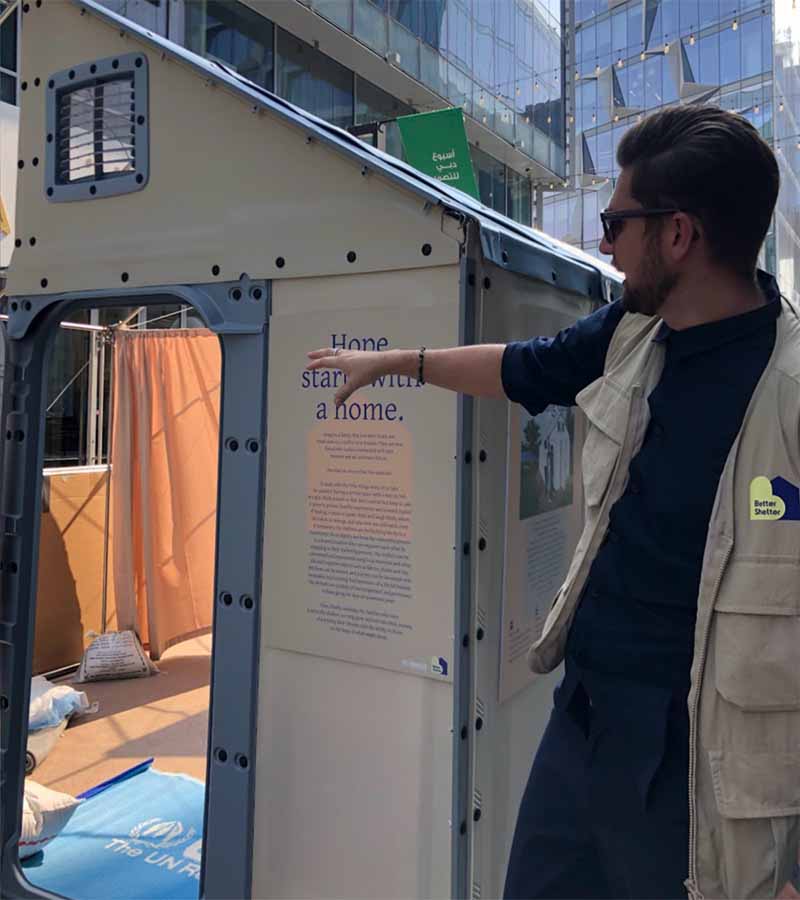
Better Shelter installation.
Located just a stone’s throw away from the Abwab pavilion, an impactful installation by Better Shelter, a not-for-profit organization specializing in emergency shelter design and production, catches the eye.
Collaborating with the IKEA Foundation and UNHCR, the housing units serve as the cornerstone for displaced families to reconstruct their lives. It offers flexibility—residents can customize and repurpose them with local materials and forgotten objects, transforming these temporary shelters into personalized and distinctive homes.
David K. Thalén, Head of Product at Better Shelter, emphasizes the dynamic nature of these shelters, viewing them as processes rather than static products. “The primary challenge is empowering the affected community to take charge of the building process.”
Thalén underscores the importance of community involvement, stating, “Shelters are processes, not a product.”
Looking ahead to the future of emergency housing, Thalén speaks of a novel approach centered on modularity and sustainability. Drawing inspiration from community insights, he emphasizes the significance of making small design choices incorporating local materials—a key tenet of human-centered design.
This forward-thinking approach addresses immediate shelter needs and lays the foundation for a more sustainable and community-driven approach to emergency housing solutions.
CAPPING IT IN
There’s a wealth of possibilities in recycling plastics, and 3Distica has harnessed this potential to construct a Sustainable Dome crafted entirely from reused bottle caps. The designers recognized the scarcity of finished products made from recycled plastic and produced a fully functional structure.
In terms of broader impact, the team envisions an expansive initiative involving establishing collection points for bottle caps throughout the city.
This strategic approach transforms waste materials into a tangible and innovative architectural form and lays the groundwork for a more sustainable and widespread recycling ecosystem within the urban environment. The Sustainable Dome becomes not just a structure but a symbol of the transformative power of recycled materials.
OF BIRDS AND BEES

Designest by Ahmad Kattan. Courtesy: Dubai Design Week
Adding another layer of intrigue to the exhibition is the Designest installation, a creation by Dubai-based designer Ahmad Kattan, who clinched the Urban Commissions award this year. The project aims to craft a design with birds in mind, resulting in a large-scale cylindrical structure inspired by the cultural significance of traditional pigeon towers scattered across the Arabian Peninsula.
Kattan explains, “The idea was to fashion something not exclusively for humans.”
While quipping that no pigeons at d3 have taken up residence in the structure yet, he shares insights from his study, indicating that pigeons typically take up to a week to ascertain the habitability of a shelter. This perspective reflects the commitment to inclusive design and offers a fascinating glimpse into the intricate dynamics between architectural innovation and the natural behaviors of its potential avian inhabitants.
REALITY CHECKS IN A DISCONNECTED WORLD
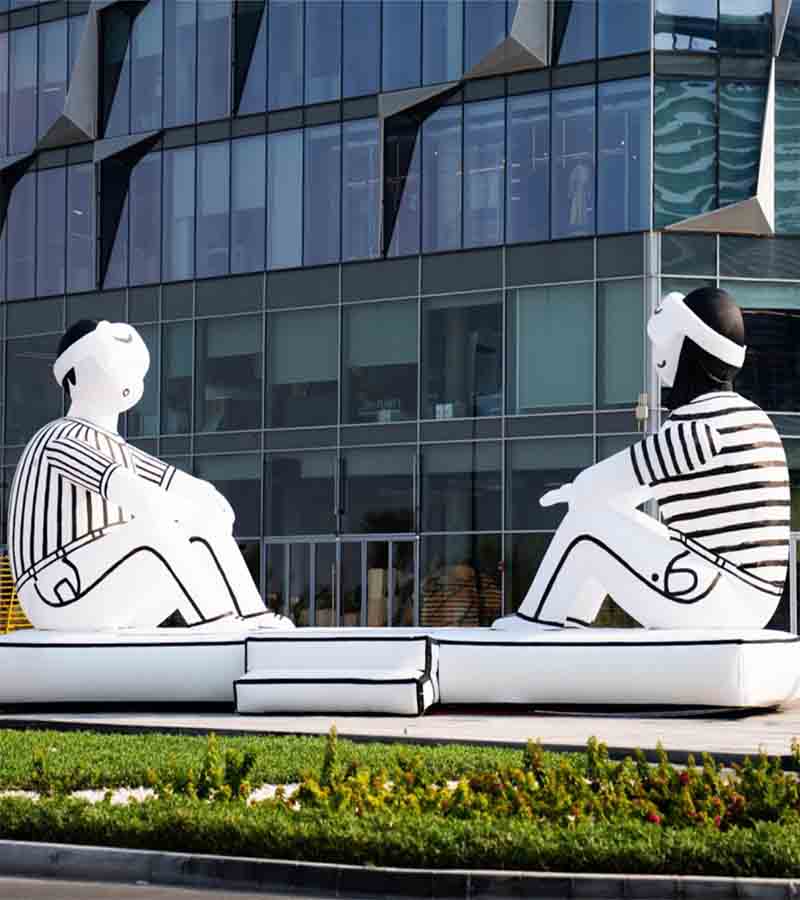
Reality Check by Kapil Bhimekar. Courtesy: Dubai Design Week
Expanding on the sustainability theme, many designers and architects are drawing attention to the escalating disconnection among humans. This sentiment echoes through various exhibits, from the purposeful design of the wood-crafted Naseej pavilion, providing a dedicated space for contemplation, to the contemplative Japanese teahouse installation crafted by Mitsubishi Jisho Design.
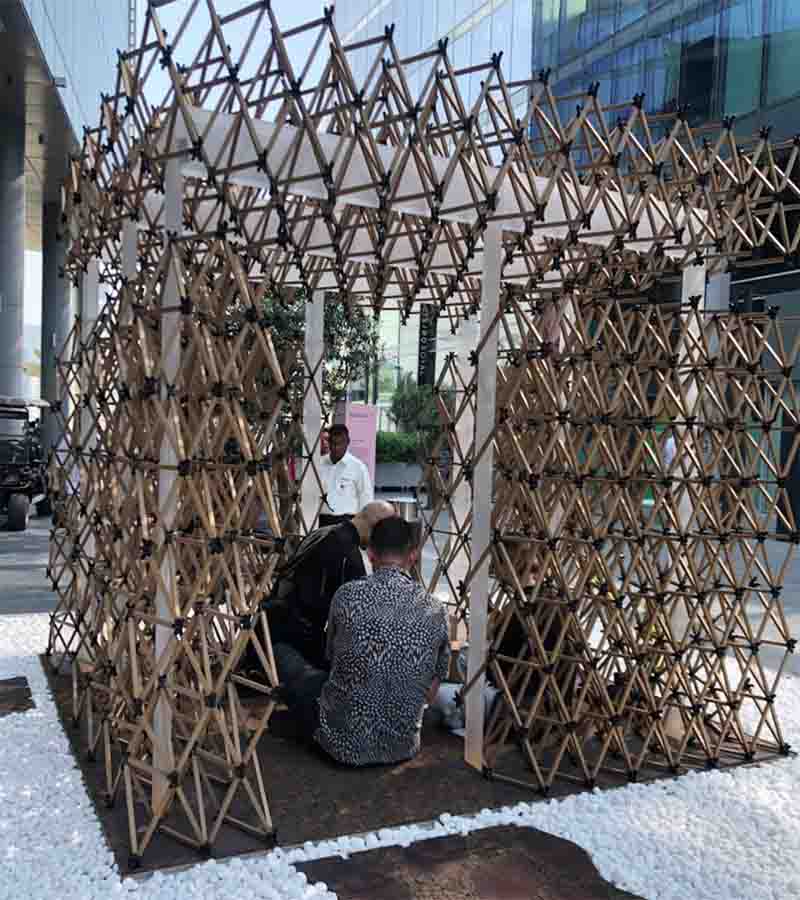
Japanese teahouse installation crafted by Mitsubishi Jisho Design.
Kapil Bhimekar’s Reality Check delves into the issue of diminishing human connections within an ever-expanding virtual realm. This prevalent theme subtly permeates the corners and details of this year’s design week, sparking reflections on the evolving dynamics of human interaction in our modern, technologically driven world.
LOCALLY SOURCED
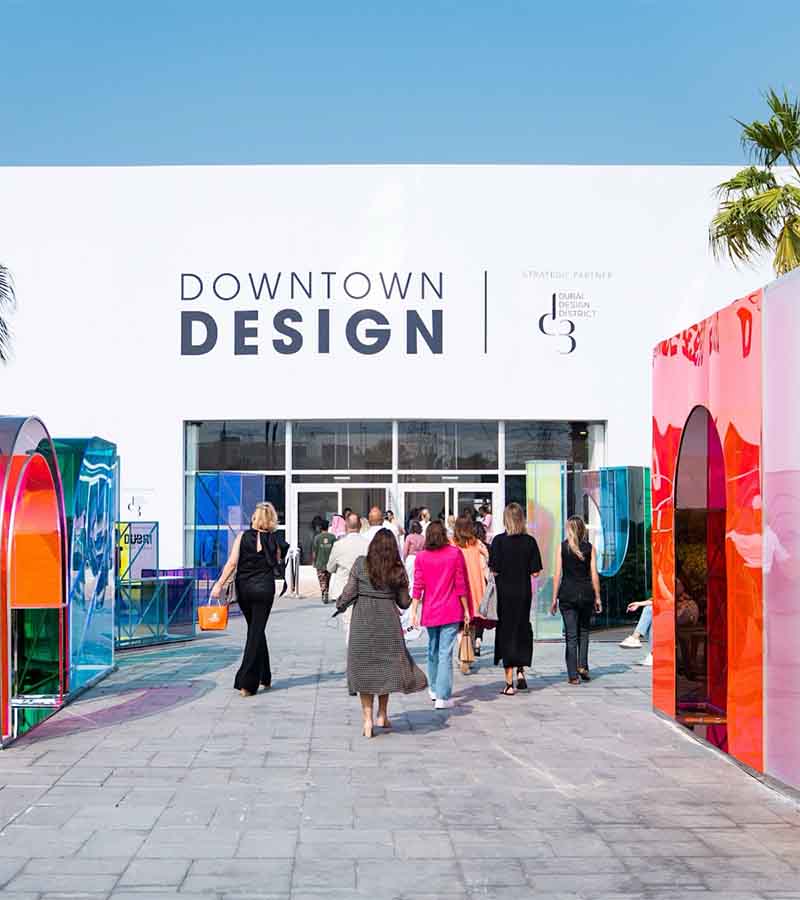
Downtown Design. Courtesy: Dubai Design Week
This year, Downtown Design showcases the latest collections, innovative products, and design solutions from over 300 prominent brands from across the globe and rising talent of the region, complemented by a program of talks, creative pop-ups, and engaging experiences.
Among the must-see exhibits are Tanween’s products crafted from fishnets and buoys; Don Tanani from Egypt presenting circular furniture; Jasmine’s Line displays handcrafted home objects; Saudi-based the Grid showcasing a gaming table, and the Fame Collective, a multidisciplinary platform highlighting artistry by female founders in the Middle East.
DESIGNING FOR THE FUTURE
Running in the atrium of Building 6 at d3, the d3 architecture exhibition aligns with COP28 and Dubai 2040 Urban Master Plan and has sustainability at its core. It will continue until the end of COP28.
More than 35 architectural studios are participating in the exhibition – from international firms like Fosters + Partners, Zaha Hadid Architects, and UN Studio to a host of local and regional studios.
All showcase projects and models around sustainable architecture across the region with several renowned regional landmarks.
Andy Shaw, Chair of the RIBA Gulf Chapter, expressed the exhibition’s goal of emphasizing the timeless nature of sustainable design. From ancient wisdom to present mastery and innovative futures, the showcase aims to trace the evolution of sustainable architecture.
Shaw also addressed the unique challenges faced by the region, emphasizing the difficulty of sustaining buildings in the harsh environment.
While acknowledging examples like Masdar, he highlighted the multifaceted nature of sustainability, encompassing passive and active design and social considerations. “In this region, sustainability leans more towards technological solutions than simply reducing building capacity.”
According to Shaw, integrating design and technology is the key to addressing sustainability challenges.
As the exhibition unfolds, it celebrates current achievements in sustainable architecture and considers the innovative solutions that will drive the region’s sustainable future.
Overall, Dubai Design Week celebrates the recent strides in sustainable architecture and charts a course toward an innovative and conscientious future for the design landscape.
Fast Company Middle East is the lead media partner for this edition’s Dubai Design Week.
With inputs from Suha Hasan.





































